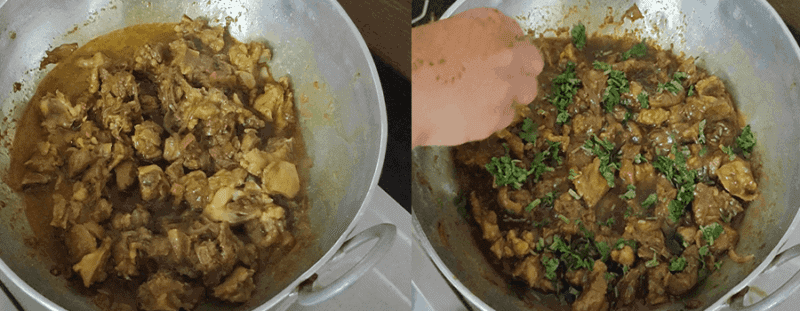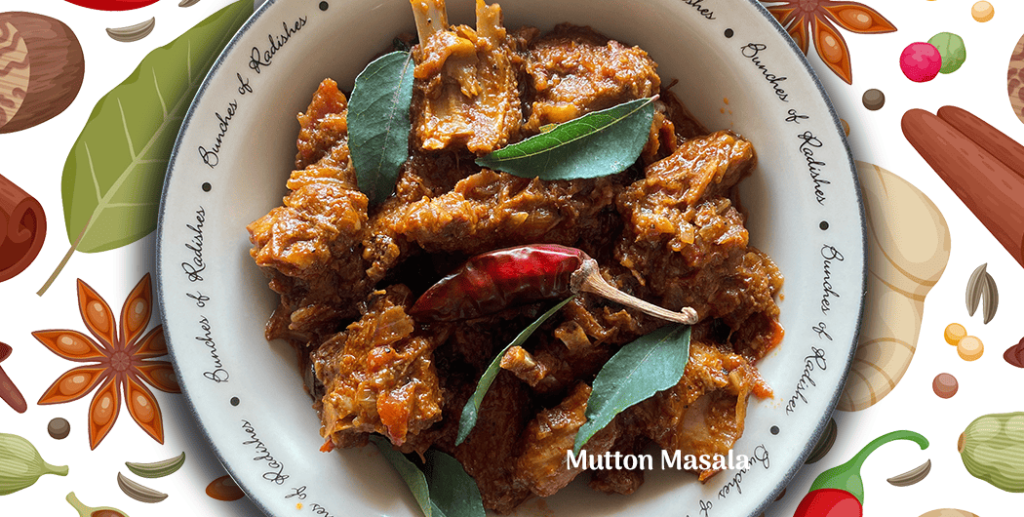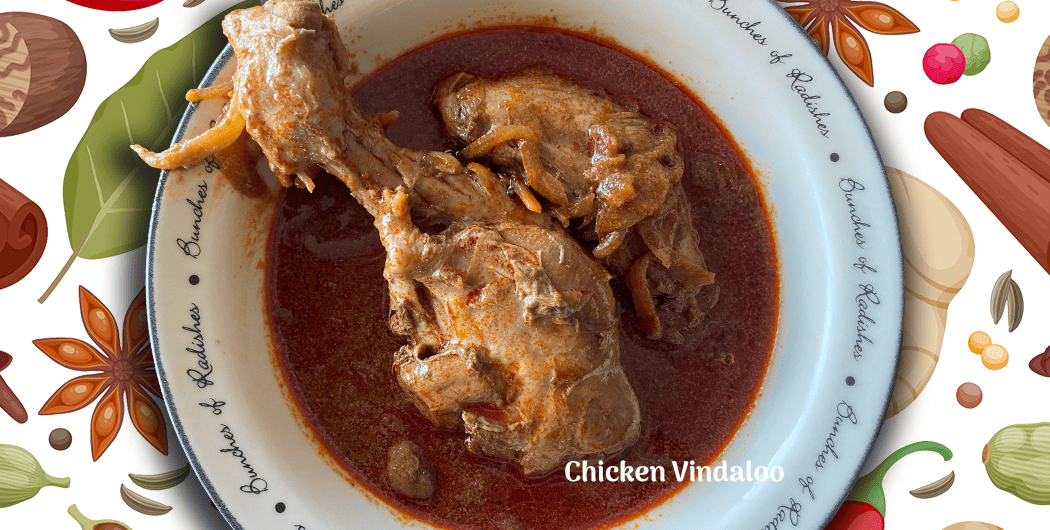Apparently Mutton Curry was originally created by wandering peoples in the deserts by mixing all the ingredients that were available together in an earthen pot and slow cooking over a wood fire. Slow cooking makes the meat more tender than normally cooked mutton––such tender meat is known as gosht––and that practice is followed even today. In this recipe also, if time permits, we recommend that the meat be slow cooked to tenderise the meat and enhance its taste and aroma. Mutton in the Indian subcontinent is the meat of goat, unlike in the west where the mutton is an older lamb. Mutton curries are always made with goat meat, and traditional preparations tend to be on the spicier side with a very oily gravy. In some regions, vegetables like potatoes and carrots are added to the curry. The fact is that the name Mutton Curry straddles a very wide range of preparations that are available across the country, and it will be presumptuous to pin point to one style and call it the authentic Mutton Curry.
This particular Goan Mutton Curry is distinctly different from the regular fares and is an ancient traditional recipe followed by the Muslim community from the Chandrawado locality of Fatorda. The Women of Fatorda Chandrawado Muttonmasala blend for this curry is also ancient, and have been handed down generations within these families, undergoing subtle variations from family to family, and from generation to generation. The following illustrated step by step method will help you with creating this everyday Mutton Curry which the Muslim community of Fatorda holds as an all time favourite for regular meals and also for celebratory events. Like all our other masalas, this masala too does all the hard work, needing very little added ingredients, and makes Goan food accessible, desirable and simple to make, allowing you to be not only an expert in Goan cooking without spending too much time in the kitchen but also a connoisseur of traditional Goan cuisine. Enjoy.
What you need –
- Mutton:1 Kg (2.2 pounds)
- Red onion: 2 large
- Tomato: 1
- Green Paste*: 3 teaspoons
- Turmeric powder: 1 teaspoon
- Water: 1 Cup (250 ml)
- Salt to season and taste
- The Women of Fatorda Chandrawado Mutton masala.
Green Paste – Green paste is a multi-purpose paste that is found in every Goan home, and is made to add in various preparations as and when needed. To make a simple green paste, Grind together 2 big bundles of fresh coriander leaves, 4-5 green chillies, 8 garlic cloves, 1/2 inch ginger and 1/2 tsp turmeric powder with a quarter cup of water. Make sure you add water a little at a time so that the paste is of thick consistency. Keep refrigerated and use as required.

Ruksana Shaikh
This recipe for the traditional Mutton Curry is from Ruksana Shaikh who hails from the Muslim community of the Chandrawado locality which is the epicentre of rich and delightful Muslim cuisine in Fatorda.
Step 1 – You need one kg of mutton on bone, cleaned and the excess water drained. You can take boneless mutton if you prefer, but the bone adds a flavour typical of sub-continent cuisine especially in curries and masala preparations that follow Muslim and Mughlai styles.

Step 2 – We need to marinate the meat. To the mutton, add two teaspoons of the green paste (please refer to how green paste
is made in the ingredients part), and add half teaspoon of turmeric powder.

Step 3 – Add also the juice of one lemon and one of the large onions sliced thinly, and some salt to season.

Step 4 – Mix them thoroughly with a spoon or with hands, rubbing the mixture into the meat and evenly coating all of it. The
more you do it, the better it is, and keep aside to marinate for at least half an hour. The more time you allow, the better it is,
and overnight marination is ideal for mutton.

Step 5 – After at least half an hour of marination, pressure cook the mutton with some water. Though the time for cooking
meat varies with the quality of mutton and the temperature, generally 3 whistles would be enough to cook to about 80 percent.

Step 6 – Check the meat to see if they are at least 80% done, and the water has reduced and the meat has become coloured
and tender. Keep it aside with the remaining water.

Step 7 – You can do the following steps while the meat is cooking. In a Kadai or a deep bottomed vessel, take 3 teaspoons of
oil––traditionally, coconut oil is used and it imparts a distinctive flavour, but any refined oil will do if you find strong flavours
from the oil unwelcome––and fry the remaining onion, again thinly sliced. Sauté them until they become translucent and light
brown, and slightly fried at the edges.

Step 8 – Add the chopped tomato to the onion and continue frying. You have to keep stirring them to ensure that they don’t
stick to the bottom of the pot.

Step 9 – Add the remaining one teaspoon of the green paste and continue frying, stirring and mixing it well.

Step 10 – Add the remaining half a teaspoon of the turmeric powder, while stirring it continuously and making a consistent
and thick paste of it.

Step 11 – Now is the time to add our Chandrawado Mutton masala. you can add 3-4 teaspoons heaps.

Step 12 – Stir for about 5 minutes, until the tomatoes are fully cooked, and the oil separates from the gravy.

Step 13 – Add the cooked mutton, stirring it into the gravy. Keep frying for about two to three minutes until the mutton is fully
coated with the gravy.

Step 14 – Add the remaining water from the cooker, lower the heat and cook it closed for about 10 minutes. Garnish with
chopped fresh coriander leaves or mint leaves or both.

Step 15 – Switch off the stove and let it remain for about 5 minutes.

Step 16 – The traditional Chandrawado mutton masala is ready for you to enjoy. You can serve it with Poi (Goan bread).














